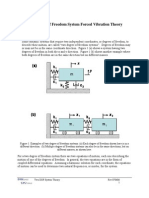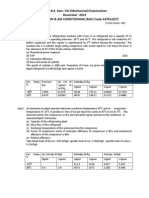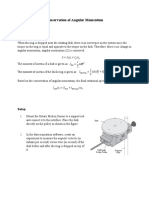Me 555 Degrees of Freedom
Me 555 Degrees of Freedom
Uploaded by
krishCopyright:
Available Formats
Me 555 Degrees of Freedom
Me 555 Degrees of Freedom
Uploaded by
krishOriginal Description:
Copyright
Available Formats
Share this document
Did you find this document useful?
Is this content inappropriate?
Copyright:
Available Formats
Me 555 Degrees of Freedom
Me 555 Degrees of Freedom
Uploaded by
krishCopyright:
Available Formats
ME 5550 Intermediate Dynamics
Degrees of Freedom of Mechanical Systems
System Configuration and Generalized Coordinates
The configuration of a mechanical system is
defined as the position of each of the bodies within
the system at a particular instant. In general, both
translation and rotation coordinates are needed to
describe the position of a rigid body. Together the
translation and rotation coordinates are called
generalized coordinates. For the simple pendulum
shown, xG and yG are translation coordinates that
describe the location of the mass center of the bar,
and is a rotation coordinate that describes the
orientation of the bar. Fig. 1 Simple Pendulum
Typically, the generalized coordinates used to define the configuration of the mechanical
system form a dependent set. That is, the coordinates are not independent of each other.
For example, for the simple pendulum of Fig.1, xG , yG , and are not independent,
because we can write the following equations.
L L
x sin ( ) y cos( )
G 2 G 2
Given the value of one of the coordinates, these equations can be used to compute the values
of the other two coordinates. So, only one of the coordinates is needed. Any pair of these
coordinates forms a dependent set.
Generalized Coordinates and Degrees of Freedom
The number of degrees of freedom (DOF) of a mechanical system is defined as the
minimum number of generalized coordinates necessary to define the configuration of the
system. For a set of generalized coordinates to be minimum in number, the coordinates
must form an independent set. Fig. 2 below shows examples of one, two, and three degree-
of-freedom planar systems.
Kamman ME 5550 page: 1/2
Fig. 2 Examples of One, Two, and Three Degree of Freedom Systems
For mechanical systems that consist of a series of interconnected bodies, it may not be
obvious how many degrees of freedom the system possesses. For these systems, the number
of degrees of freedom may be found by first calculating the number of degrees of freedom
the system would possess if the motions of all the bodies were unrestricted and then
subtracting the total number of constraints on the motion. For example, for the slider crank
mechanism shown in Fig. 2, we can calculate the number of degrees of freedom in the
following ways:
a) Counting 3 Bodies: (crank, slider, and connecting bar)
3 Bodies @ 3 DOF = 3*3 = 9 DOF
3 Pin Joints = 3*2 = 6 constraints
1 Slider Joint = 1*2 = 2 constraints
Total DOF = 9-6-2 = 1 DOF
b) Counting 2 Bodies: (crank and connecting bar)
2 Bodies @ 3 DOF = 2*3 = 6 DOF
2 Pin Joints = 2*2 = 4 constraints
1 Pin/Slider Joint = 1*1 = 1 constraint
Total DOF = 6-4-1 = 1 DOF
Kamman ME 5550 page: 2/2
You might also like
- Lecture 2 Degrees of FreedomDocument105 pagesLecture 2 Degrees of FreedombourneNo ratings yet
- Solutions2 PDFDocument5 pagesSolutions2 PDFApuNo ratings yet
- Theory For Two Degree of Freedom SystemsDocument4 pagesTheory For Two Degree of Freedom SystemsRajiv ThambotheranNo ratings yet
- Electrical Machines Lab-II ManualDocument41 pagesElectrical Machines Lab-II Manualsuresh270No ratings yet
- Radiation (Chapter14)Document39 pagesRadiation (Chapter14)Janice OmadtoNo ratings yet
- Survey On: "Real Time Water Quality Monitoring System Using Iot and Machine Learning"Document3 pagesSurvey On: "Real Time Water Quality Monitoring System Using Iot and Machine Learning"Snehal100% (1)
- Transformer - Electrical MachineDocument35 pagesTransformer - Electrical Machinemenilanjan89nLNo ratings yet
- CH 2: Fundamentals of Kinematics: - Topic OutlineDocument36 pagesCH 2: Fundamentals of Kinematics: - Topic OutlineJohn FiveNo ratings yet
- Vibrations of Two Degree of Freedom SystemsDocument28 pagesVibrations of Two Degree of Freedom SystemsKautilyaChennaNo ratings yet
- Piping Engineer SyllubusDocument3 pagesPiping Engineer SyllubusbalajivangaruNo ratings yet
- 11 Physics Notes 10 Oscillations and WavesDocument21 pages11 Physics Notes 10 Oscillations and WavesAkshay SharmaNo ratings yet
- Ship Safety An Environmental Protection Instruction:: Total Time 120 Min Total Question 50 Uscg First 200 QuestionDocument40 pagesShip Safety An Environmental Protection Instruction:: Total Time 120 Min Total Question 50 Uscg First 200 QuestionSheikh MonirulNo ratings yet
- Decision MakingDocument36 pagesDecision Makingronami100% (1)
- 8 Vapour Power CycleDocument6 pages8 Vapour Power CycleSurendar PerumalNo ratings yet
- Engine Friction PDFDocument24 pagesEngine Friction PDFsushil.vgiNo ratings yet
- Me Lab 2Document14 pagesMe Lab 2Lennin John CaguioaNo ratings yet
- Chap 012Document50 pagesChap 012Nguyễn TúNo ratings yet
- Chapter 4 Illumination1Document37 pagesChapter 4 Illumination1GurusumiNo ratings yet
- Cseb ReportDocument25 pagesCseb Reportshchan530% (1)
- Heat Exchangers II ModuleDocument54 pagesHeat Exchangers II ModuleShivam PandeyNo ratings yet
- UNIT-III Three Phase & Single Phase Induction MotorsDocument8 pagesUNIT-III Three Phase & Single Phase Induction MotorsRahulRamamoorthyNo ratings yet
- Electrical Machine PDFDocument40 pagesElectrical Machine PDFAanjenay PandeyNo ratings yet
- Basic Principles Basic Transformer Parameters and Construction Construction Conclusion BibliographyDocument17 pagesBasic Principles Basic Transformer Parameters and Construction Construction Conclusion BibliographySHANKAR PRINTINGNo ratings yet
- Bab 2-DC MOTORDocument35 pagesBab 2-DC MOTORAfieza TumijanNo ratings yet
- EE483-Power System Protection-Syllabus PDFDocument2 pagesEE483-Power System Protection-Syllabus PDFdeniNo ratings yet
- Module For Machine ElementsDocument28 pagesModule For Machine ElementsAce Heart Rosendo AmanteNo ratings yet
- Elements and Problems ICECH11Document13 pagesElements and Problems ICECH11Nobel Engzen Du BermoyNo ratings yet
- 14thermal Expansion of Materials - 227-249Document11 pages14thermal Expansion of Materials - 227-249KAMAL KANT KUSHWAHANo ratings yet
- Elem Handouts Topics 1&2Document10 pagesElem Handouts Topics 1&2Escalona, Michael Joshua S.No ratings yet
- Chapter 1 IntroductionDocument26 pagesChapter 1 IntroductionGeraldine ChanNo ratings yet
- Heat Chapter 1Document23 pagesHeat Chapter 1Kale DireNo ratings yet
- Question Paper For RACDocument2 pagesQuestion Paper For RACSDvidyaNo ratings yet
- Two Sample T-TestDocument95 pagesTwo Sample T-TestJOMALYN J. NUEVONo ratings yet
- WYE (Y) and DELTA ( ) ConversionDocument12 pagesWYE (Y) and DELTA ( ) Conversionvamps sierNo ratings yet
- Chapter 4 RadiationDocument47 pagesChapter 4 RadiationKamal JamaliNo ratings yet
- Elmachi1 - Lecture13 (General EMF Equation of A DC Machine)Document15 pagesElmachi1 - Lecture13 (General EMF Equation of A DC Machine)Trisha SARMIENTONo ratings yet
- Automated Hydroponics With Remote Monitoring and CDocument5 pagesAutomated Hydroponics With Remote Monitoring and CAnantha BhatNo ratings yet
- Ideal and Practical TransformerDocument8 pagesIdeal and Practical TransformerChintal.vinodNo ratings yet
- Radiation 1Document26 pagesRadiation 1Malek Marry AnneNo ratings yet
- Chapter 6 SiskindDocument2 pagesChapter 6 SiskindNicole Irene Dela PenaNo ratings yet
- Thermal CyclesDocument6 pagesThermal CyclesSathish Kasilingam0% (1)
- Unit IV TransformerDocument31 pagesUnit IV TransformerParikshit SinghNo ratings yet
- Mechanical Vibrations QuizzDocument16 pagesMechanical Vibrations QuizzSagan PreetNo ratings yet
- Heat Exchangers in Refrigeration - English PDFDocument1 pageHeat Exchangers in Refrigeration - English PDFavramusNo ratings yet
- IoT-Based Water Monitoring SystemDocument5 pagesIoT-Based Water Monitoring SystemManuel Luis Delos Santos0% (1)
- Problems in Heat ExchangersDocument4 pagesProblems in Heat ExchangersNkoshiEpaphrasShoopalaNo ratings yet
- Power System Protection Lab 1Document12 pagesPower System Protection Lab 1Ronny VelásquezNo ratings yet
- 13-2103471 Engine Friction and LubricationDocument25 pages13-2103471 Engine Friction and LubricationDime Sac100% (1)
- Ch-2 Electrical Circuit Anlysis-PART 1Document44 pagesCh-2 Electrical Circuit Anlysis-PART 1temesgen adugnaNo ratings yet
- Four Bar LinkageDocument13 pagesFour Bar LinkageMBHladilekNo ratings yet
- Laboratory Exercise No. 1Document4 pagesLaboratory Exercise No. 1Alexander IgasanNo ratings yet
- DC Motor PresentationDocument31 pagesDC Motor PresentationDony Beast (DurraniFared)No ratings yet
- Three Phase SystemDocument8 pagesThree Phase Systemdonhamsa8032No ratings yet
- Wires and Cables Used For Residential Electrical SystemsDocument3 pagesWires and Cables Used For Residential Electrical SystemsNurul ShathirahNo ratings yet
- Notes Kinematics MachinesDocument46 pagesNotes Kinematics MachinessmikedaneNo ratings yet
- Analysis of Variance (ANOVA) : Table 1 K Random SamplesDocument5 pagesAnalysis of Variance (ANOVA) : Table 1 K Random SamplesAisha FarooqNo ratings yet
- Me 459 Degrees of FreedomDocument3 pagesMe 459 Degrees of FreedomZoya ZoyaNo ratings yet
- Designing A Neuro PD With Gravity Compensation For Six Legged RobotDocument8 pagesDesigning A Neuro PD With Gravity Compensation For Six Legged RobotVishwanath KetkarNo ratings yet
- Lect Degrees of FreedomDocument111 pagesLect Degrees of FreedomZeeshan Rafiq100% (1)
- Theory of Machines, MT 215: Kinematic FundamentalsDocument29 pagesTheory of Machines, MT 215: Kinematic FundamentalscritestachNo ratings yet
- The Direct Stiffness Method: Assembly and SolutionDocument14 pagesThe Direct Stiffness Method: Assembly and SolutionShubhankar BhowmickNo ratings yet
- (E Rosado, S L Rueda) Affine and Projective Geometry - Conics and QuadricsDocument41 pages(E Rosado, S L Rueda) Affine and Projective Geometry - Conics and QuadricsGabrielDNo ratings yet
- Original Dhva Data of BismuthDocument17 pagesOriginal Dhva Data of BismuthKrishna B ma21m015No ratings yet
- The Jacobian of A Transformation 2Document4 pagesThe Jacobian of A Transformation 2Ankur Singh100% (1)
- 1 - Matrices and Their Applications PDFDocument94 pages1 - Matrices and Their Applications PDFUjjwal NathNo ratings yet
- Weinberg 1109.6462v3Document13 pagesWeinberg 1109.6462v3Mario Cacasenno100% (1)
- Electric Charges and FieldsDocument19 pagesElectric Charges and FieldsThayumanavar Sachithanantham100% (1)
- ATM-3 - The 2nd Law of ThermodynamicsDocument39 pagesATM-3 - The 2nd Law of Thermodynamics廖奕翔No ratings yet
- Angular Momentum ConservationDocument3 pagesAngular Momentum ConservationSagar PatadiaNo ratings yet
- Daisie Thor - Conspiracy Theory EssayDocument5 pagesDaisie Thor - Conspiracy Theory Essayapi-544333098No ratings yet
- Airy FunctionDocument10 pagesAiry Functionalokesh1982No ratings yet
- ProblemSheet7 MAST30030 2015Document2 pagesProblemSheet7 MAST30030 2015Brofessor Paul NguyenNo ratings yet
- Field SS1Document6 pagesField SS1OLUSOLA OLUBORODENo ratings yet
- Skills in Mathematics Integral Calculus For JEE Main and Advanced 2022Document319 pagesSkills in Mathematics Integral Calculus For JEE Main and Advanced 2022Harshil Nagwani100% (4)
- 1D Ising ModelDocument3 pages1D Ising Modelprathap.hcuNo ratings yet
- Full Principles of Radiation Interaction in Matter and Detection 4th Edition Claude Leroy PDF All ChaptersDocument52 pagesFull Principles of Radiation Interaction in Matter and Detection 4th Edition Claude Leroy PDF All ChaptersbashsajijNo ratings yet
- Math 677. Fall 2009. Homework #4 SolutionsDocument3 pagesMath 677. Fall 2009. Homework #4 SolutionsRodrigo KostaNo ratings yet
- Noether's Theorem - FinalDocument10 pagesNoether's Theorem - FinalZechNo ratings yet
- HD 11 Damped Modal Analysis 2008Document10 pagesHD 11 Damped Modal Analysis 2008Oliver KrausNo ratings yet
- Commutator - WikipediaDocument6 pagesCommutator - WikipediakamaalNo ratings yet
- Quantenoptik Vorlesung10 PDFDocument11 pagesQuantenoptik Vorlesung10 PDFErinSuttonNo ratings yet
- Field Theories of Condensed Matter PhysicsDocument856 pagesField Theories of Condensed Matter PhysicsFree Fast100% (2)
- A Level PhysicsDocument159 pagesA Level PhysicsvinuyeNo ratings yet
- R A F T: Notes On Statistical MechanicsDocument177 pagesR A F T: Notes On Statistical MechanicsmorganNo ratings yet
- The Atomic Vortex Hypothesis, A Forgotten Path To UnificationDocument10 pagesThe Atomic Vortex Hypothesis, A Forgotten Path To UnificationenricluzNo ratings yet
- PHYSICAL SCIENCE MODULE 9 EditedDocument32 pagesPHYSICAL SCIENCE MODULE 9 EditedTimothy PajeNo ratings yet
- Making Sense of The Legendre TransformDocument10 pagesMaking Sense of The Legendre TransformFaisal AmirNo ratings yet
- Hilbert Transformer Notes-5Document10 pagesHilbert Transformer Notes-5prajwalNo ratings yet
- Dot Product and Cross ProductDocument2 pagesDot Product and Cross ProductShahwez AlamNo ratings yet
- BSC I Yr Chapter 1Document8 pagesBSC I Yr Chapter 1pankajNo ratings yet

























































































